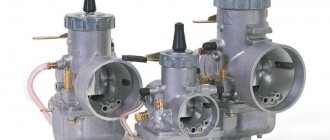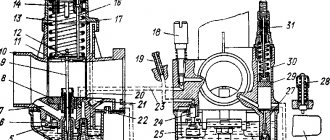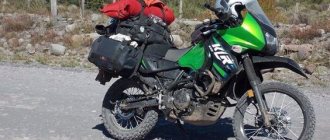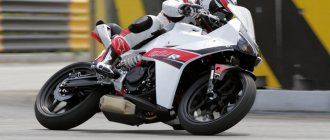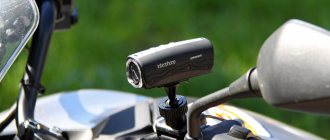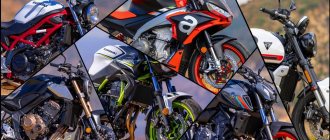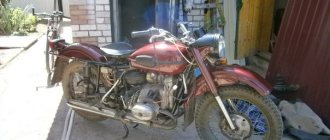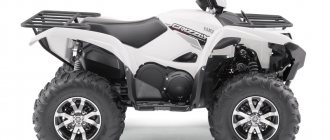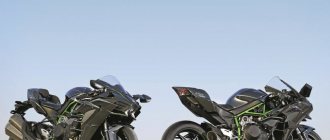| Yamaha YZF-R25 (2015-2018) | Yamaha YZF-R25 (2019+) |
Model of the budget sports motorcycle Yamaha YZF-R25
was first introduced in 2015 in parallel with the Yamaha YZF-R3 version. Both models are almost identical, differing only in engine size. The Yamaha YZF-R25 version is equipped with a 249 cm³ engine, YZF-R3 - with a 321 cm³ engine. The Yamaha R25 also has different gearbox settings and a slightly reduced overall weight.
The main sales market for the Yamaha YZF-R25 is Japan (the model may also be available in Southeast Asia, Turkey and some other countries).
Like the R3, the YZF-R25 has 2 main generations:
- I generation
— 2015-2018 - II generation
— 2019+.
The second generation features an updated appearance, LED optics, LCD instrumentation and an inverted fork.
For more detailed history and technical features of the model, read the main article - Yamaha YZF-R3.
The main competitors of the Yamaha YZF-R25 in the class:
- Honda CBR250RR 2017
- Kawasaki Ninja 250
- Suzuki GSX250R
Brief history of the model
- 2015 - start of production and sales of Yamaha YZF-R25. First generation.
Model
: Yamaha YZF-R25; Yamaha YZF-R25A (ABS) (Japan).
- 2016 - no significant changes.
Model
: Yamaha YZF-R25; Yamaha YZF-R25A (ABS) (Japan).
- 2017 - no significant changes.
Model
: Yamaha YZF-R25; Yamaha YZF-R25A (ABS) (Japan).
- 2018 - no significant changes.
Model
: Yamaha YZF-R25; Yamaha YZF-R25A (ABS) (Japan).
- 2019 - restyling of the model. Second generation
.
Model
: Yamaha Yamaha YZF-R25; Yamaha YZF-R25 ABS (Japan).
- 2020 - no significant changes.
Model
: Yamaha Yamaha YZF-R25; Yamaha YZF-R25 ABS (Japan).
- 2021 - no significant changes.
Model
: Yamaha Yamaha YZF-R25; Yamaha YZF-R25 ABS (Japan).
Specifications
Yamaha R25 (YZF-R25) Specifications:
| Model | Yamaha R25 (YZF-R25) |
| Motorcycle type | sport |
| Year of issue | 2015+ |
| Frame | steel |
| engine's type | 2-cylinder, 4-stroke, in-line |
| Working volume | 249 cm³ |
| Bore/Stroke | 60.0 x 44.1 mm |
| Compression ratio | 11,6:1 |
| Cooling | liquid |
| Number of valves per cylinder | DOHC, 4 valves per cylinder |
| Fuel supply system | injector |
| Ignition type | TCI |
| Maximum power | 35.0 hp (26.0 kW) at 12000 rpm |
| Maximum torque | 23.0 Nm (2.4 kg*m) at 10,000 rpm |
| Clutch | Multi-disc in oil bath, cable drive |
| Transmission | 6-speed |
| type of drive | chain |
| Front tire size | 110/70-17M/C (54S) |
| Rear tire size | 140/70-17M/C (66S) |
| Front brakes | 1 disc, 298 mm, 2-piston caliper (optional ABS) |
| Rear brakes | 1 disc, 220 mm, 1-piston caliper (ABS optional) |
| Front suspension | 41 mm telescopic fork (non-adjustable), 130 mm travel 37 mm inverted fork, 130 mm travel - from 2022 |
| Rear suspension | pendulum with monoshock absorber (preload adjustment), stroke - 125 mm |
| Length | 2090 mm |
| Width | 720 mm 730 mm - from 2022 |
| Height | 1135 mm 1140 mm - from 2022 |
| Wheelbase | 1380 mm |
| Minimum ground clearance (clearance) | 160 mm |
| Seat height | 780 mm |
| Acceleration 0-100 km/h (0-60 mph) | 7.5 sec[1] |
| Maximum speed | 188 km/h[2] |
| Gas tank capacity | 14.0 l (including reserve - 3.0 l) |
| Motorcycle weight (curb) | 166 kg – YZF-R25 (2015-2018) 167 kg – YZF-R25 (2019+) 169 kg – YZF-R25 (ABS) 2015-2018 170 kg – YZF-R25 (ABS) 2019+ |
Honda CBR300R, Suzuki GSX250R, Yamaha YZF-R3, Kawasaki Ninja 400 and KTM RC390: which is better?
There's never been a better time to own a small motorcycle, namely a small sportbike.
For decades, the small-capacity motorcycle segment was dominated by the Kawasaki Ninja 250, which was designed to compete with the likes of the Hyosung, but over the past few years, the budget sportbike arms race has reached new heights. Honda debuted the CBR250R, which soon grew into the CBR300R, Kawasaki upgraded its baby to the Ninja 300. Then the KTM RC390, Yamaha's R3 and Suzuki GSX250R entered the arena. And this year, Kawasaki's Ninja 400 debuted to erase the 40 hp. power of the KTM RC390 and become a segment leader.
It's great to see these bikes in showrooms and on city streets, but it puts a newbie in a tough spot, especially if he's looking to purchase one of these. Many questions arise. Which motorcycle is better? Which one is best for me? During a long test of motorcycles for novice riders, many kilometers were covered and a large number of opinions were collected about each one.
Below in the article are the strengths and weaknesses of each motorcycle individually. We hope that this will help a beginner make an informed decision in favor of one or another instance.
Honda CBR300
The little CBR debuted in 2011. It's a well-handling bike with excellent brakes, well-balanced suspension and a torquey single-cylinder engine. In 2015, Honda increased the engine capacity to 286 cc. and updated the appearance to make the bike more similar to the older CBRs.
When it comes to functionality, the Honda is hard to beat. Apart from the lack of linear acceleration and top speed, this is a fun little bike that is easy to use and accessible to everyone. Honda has always been famous for this approach.
The CBR300R is fun and easy to drive. It's quick to taxi, has excellent brakes, and torque is available from the bottom.
The CBR300R can be had for $4,699 without ABS, but ABS is definitely a welcome feature and adds just $300 to the cost and 4.5kg to curb weight. Even with ABS and a full tank, the bike weighs only 166 kg. This is the lightest motorcycle presented. And you really feel it, whether you're driving it or just rolling it out of the garage. The narrow bike is great for short riders. But even tall riders will find it comfortable, thanks to well-placed handlebars and footpegs.
The dashboard is nothing special, but it gets the job done.
The increase in engine displacement added a little more power (26.7 versus 24 for the CBR250). The appearance of the CBR300R makes you fall in love with it. But in terms of performance, the Honda feels weak compared to its rivals.
The CBR may not be as powerful, but the bike handles much better than others in its class and has the best brakes with the exception of the RC390. The single-cylinder engine feels busy on the motorway at around 120km/h, but around town its low-end torque is a real reward, with the engine efficient up to 80km/h.
If your habitat is a city or a highway with low speeds, then Honda is an ideal option.
Suzuki GSX250R
Suzuki's first attempt to enter the small-capacity motorcycle market with the GW250 (Inazuma) grew into the creation of the GSX250R. The huge muffler and front fender are vaguely reminiscent of the GW250. The little GSX looks sleek, with a design similar to its big brothers.
Suzuki has more than just a whiff of GSX-R styling.
The base price of the motorcycle is $4,499, which is the lowest price in the category. The power unit of the motorcycle is a 248 cc parallel twin, which produces 20.6 hp (data from the dyno) and 20.3 Nm of torque. This is the smallest of all motorcycles in this class, less than half the power of the Ninja 400 and RC390. Even at 6 hp. less than a single-cylinder Honda.
Another disadvantage of the Suzuki is its weight. If the average weight of motorcycles in the test is 167 kg, then the GSX is 11.7 kg heavier than the others. In addition, the seat is about 10mm higher than the Yamaha and Honda. Even a photographer who took photos of the motorcycles during the test noticed this.
The best feature of the GSX250R is its simple two-color LCD display. All information on it is clear and easy to read.
This is all bad news, but in practice the GSX250 is good. The motorcycle handles well, even considering its weight, and generally behaves just like the others. It is also comfortable for tall riders. Has reasonable ergonomics and a decent seat. And finally, the dashboard is easy to read and filled with all the necessary information. The only negative is the front brake. He is the worst among all the participants and has no ABS.
The GSX250 is a good and beautiful motorcycle that will serve you faithfully. But it's hard to recommend when there are other similarly priced bikes that perform better and have more features.
Yamaha YZF-R3
The Yamaha YZF-R3 is based on its predecessor. This is the Yamaha R25 that has graced showrooms around the world for many years. The motorcycle shares many parts with the Yamaha R3. The latter is distinguished from the R25 by an increased piston diameter from 60 to 68 mm. This also means the bike has a more traditional crankshaft, so the R3 engine performs like the Ninja and GSX, rather than the R1 and MT-07 engines. The parallel 320.6 cc twin on the dyno produced 35.1 hp. This figure puts it on par with KTM and Kawasaki, even the weight of 168 kg is close to the weight of motorcycles of the “green” and “orange” brands.
The Yamaha R3 is a typical sports bike. It looks aggressive without losing comfort and versatility.
Even as the second heaviest bike of the group, the R3 scores highly for usability. Everything from the 787mm seat height to the clutch and transmission is superb, especially for a beginner. But more experienced riders who can test the bike to its limits will definitely find shortcomings. The front brake is not as weak as, for example, the Suzuki, but it lacks feedback and power when you increase the pace. The same applies to the rear shock absorber, which is not helped even by adjusting the spring preload.
Perhaps the worst thing about the motorcycle is the Michelin tires, which are not intended for sport riding. Yes, company representatives say that the tires will withstand a mileage of 16,000 kilometers, but this is not the best option for the first track day.
The award for best instrument panel had to go to Yamaha. It looks like an element of the cabin of a spaceship. Perfectly displays all the necessary information. The transparent indicator on top is a blinker.
The good news is that the R3's problems are easily fixed, especially the tires, and everything else about the bike is excellent. The designers did a good job with the dashboard. She looks like she was taken from a science fiction movie. The digital speedometer is easy to read, as is the large analog tachometer dial. The blinker, gear indicator and fuel gauge get top marks.
At the end of the day, the R3 has the same problems as the Suzuki. It's tough competition. The basic version of the motorcycle costs $4,999 ($5,299 for the version with ABS). The price is more than fair, but you'll need a little more notes to buy it. But still, Yamaha is an option that you can choose with pride.
Kawasaki Ninja 400
In all honesty, the outgoing Ninja 300 was a great bike for any level of rider. But Kawasaki bet on 2022 and completely redesigned the bike. Engine with increased volume to 399 cc. installed in a completely new frame. The optics have become completely LED. In addition to the above, the Ninja 400 has received many improvements compared to its predecessor.
In profile, the Ninja 400 looks sporty. The wheel rim stripes look amazing at speed.
Making stops faster, throttle response more efficient, and reducing weight is great, but the effort can be hampered by the cost. Fortunately, Kawasaki has kept the Ninja 400 price at $4,999 (non-ABS version). A motorcycle with ABS costs $300 more, which is reasonable considering how much safer emergency braking becomes.
Even with ABS, the bike weighs 168 kg. This is more than 6 kg less than the weight of its predecessor.
The engine power is 43.4 hp (data from the dyno), which makes it the most powerful of the participants.
The Kawasaki gets a dashboard with a large analogue tachometer and a digital speedometer and gear indicator. This is the only instrument panel that beats the R3.
As for driving characteristics, the motorcycle is excellent for both everyday use and for trips to the track. The ergonomics are neutral and comfortable, the suspension is well-tuned, and the engine's power rise is linear, with thrilling power delivery at peak and high redline at 12,500 rpm. The fit of parts and overall finishing are top notch. And if you are looking for a fully functional dashboard, then the Ninja 400 is what you need.
Complaints about the bike centered on the brakes being too flimsy and the muffler being a problem if you have large feet.
This is a versatile and stylish little sportbike, ready to take you to work or hit the highway on the weekend.
KTM RC390
When the RC390 hit the streets in 2014, it was a revolution. It was a sizzling hot sportbike from a manufacturer that was more focused on enduro. Everyone took notice, from novice motorcyclists to riders on a BMW R1200GS with 100,000 miles on the odometer. And this is not surprising. Just look at him. The RC390 is a tall, narrow and aggressive motorcycle. As stated earlier: “This is a real sportbike, just small.”
It's hard to argue that any of the other motorcycles are more attractive than the KTM RC390. Just look at the tubular frame and 320mm brake disc.
The motorcycle has a high, but not particularly comfortable seat, low-mounted clip-ons, a too hot engine, a small fuel tank and a hard rev limiter. But who cares?
The price of the RC390 is close to the Ninja 400. The motorcycle can be purchased only with ABS for $5,499. There is no version without ABS, but the system can be turned off using a button on the dashboard.
The 373cc single-cylinder engine seems to be working at its limit considering it produces 42.5bhp. and 33 Nm of torque. The engine is noisy at idle and while driving, but is strong enough for cruising on country roads and winding roads.
The KTM dashboard is too simple. The tachometer at the top of the screen is small and difficult to read, as is the rest of the information.
For 2022, KTM gets a larger front brake rotor, adjustable levers and new mirrors. The motorcycle is equipped with lensed head optics, inverted forks and has a distinctive style. Plus, it weighs an impressive 168 kg with a full tank.
What the bike lacks compared to the Kawasaki and Honda is practicality and refinement. Like a true sportsbike, the RC390 is light on comfort. And it can't be ignored that the RC390 has a history of mechanical problems, which makes the KTM not very attractive if you use a motorcycle as your only means of transportation. However, for most people, a motorcycle should not be practical. It should give emotions and be exciting. And in this regard, the RC390 dominates.
Let's sum it up
This battle for supremacy in the small-capacity motorcycle segment came down to the two largest motorcycles. All other motorcycles are weaker and slightly behind in performance compared to Kawasaki and KTM, but this is not only because the latter are the most powerful. While more power is a good thing, these two bikes are truly the right choice. Switchable ABS, adjustable levers on the KTM or excellent instrumentation on the Kawasaki.
In the end we came to these two motorcycles and this is not surprising.
The Ninja 400 and RC390 have almost the same specifications and price. Kawasaki had more time and more models in the segment to finally release the perfect motorcycle. This proves that the Ninja 400 is ideal for everyday riding and has received all the necessary improvements for the rider. This is an excellent and well designed bike.
KTM's RC390 feels like a small sportbike, more like a baby Ducati Panigale. It's an aggressive bike, even though it's small.
The biggest surprise of the test was the bike from Honda, which has an excellent chassis and build quality, but lacks the features of the KTM and Kawasaki.
So, can you imagine yourself driving the legendary and versatile Ninja in KRT livery? Or do you want a sporty, track-oriented KTM with a trellis frame and a hot engine? It's actually good that there is no right answer to these questions. Even Honda and Yamaha are good choices.
If you choose a KTM RC390, then all the eyes of passers-by will be directed in your direction, but a smart decision would be to put a Kawasaki Ninja 400 in your garage.
